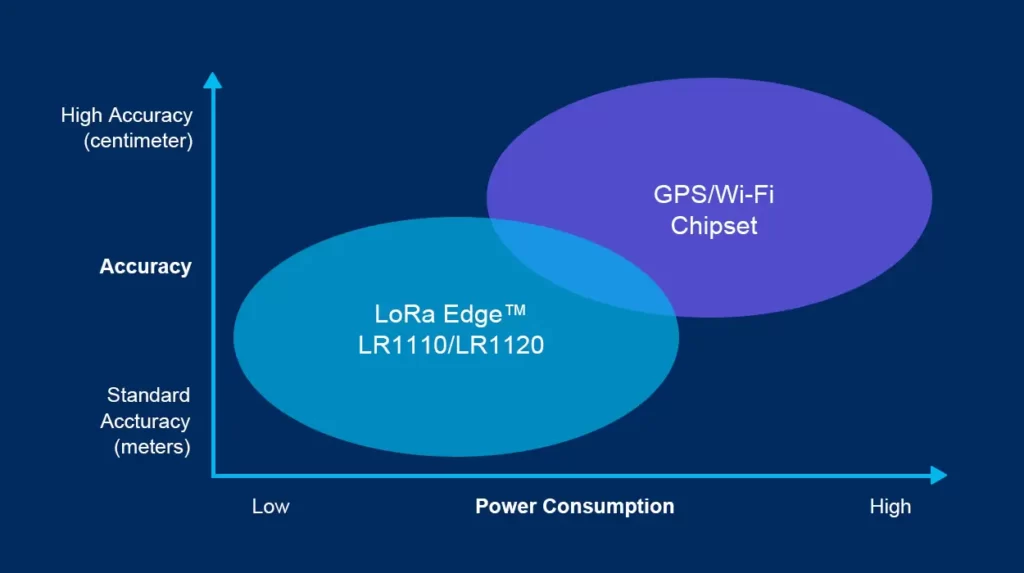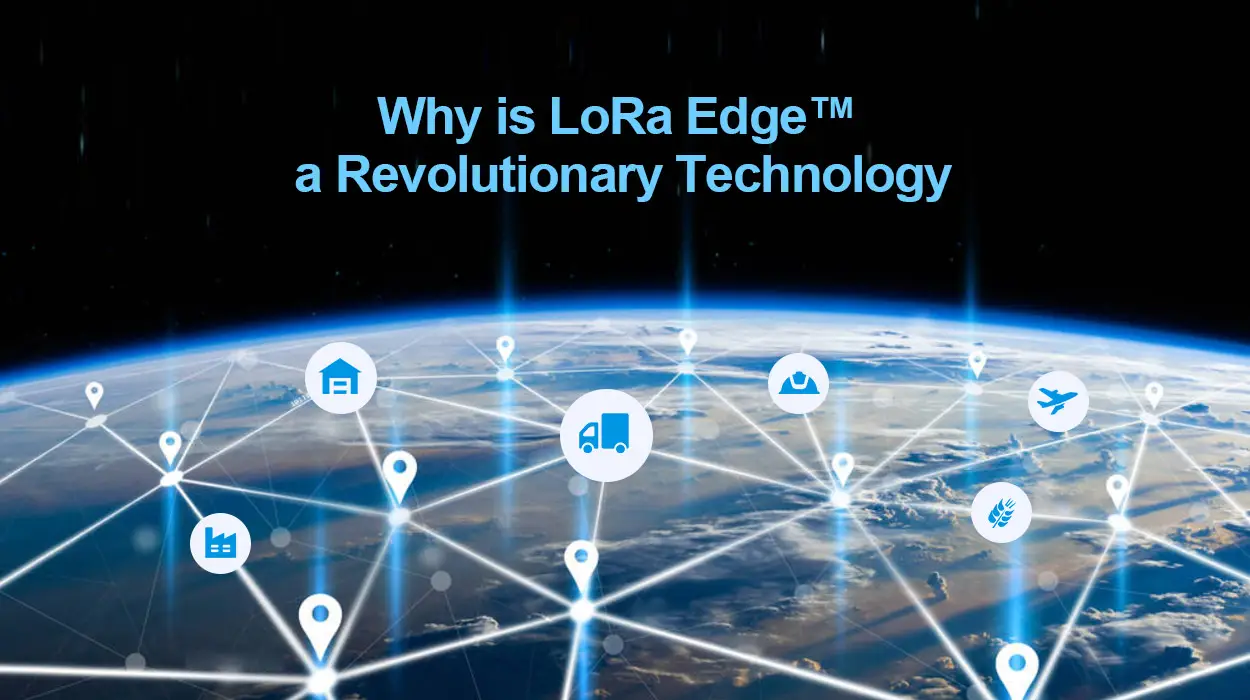As early as the 15th century, positioning technology was born when mankind began its exploration of the ocean. However, the positioning method at that time was somewhat crude, simply using nautical charts and star charts to roughly determine the position. Up to now, positioning technology has made great strides in technical means, positioning accuracy, availability and so on. Statista forecasts that there will be more than 29.4 billion IoT connected devices worldwide by 2030, most of which will need to provide some form of location capability. If you need a secure end-to-end positioning solution with low cost and low power consumption, LoRa Edge is a pretty good choice.
What is LoRa Edge
The LoRa Edge introduced by Semtech is based on LR series chips, including low power LoRa transceiver, integrated GNSS and WiFi scanning technology, as well as unique architecture, which can be located and tracked by cloud-based geolocation server. Simply put, LoRa Edge is a highly integrated chipset that provides a secure location solution from device to cloud. The LoRa Edge platform completes positioning through the cloud rather than on the device itself, significantly reducing power consumption.
By adding LoRa Cloud geolocation services and providing easy-to-use and cost-effective TDOA data, GNSS and WiFi-based cloud location computing capabilities, the power requirements of devices are dramatically reduced and asset management efficiency is greatly improved. LoRa Edge enables users to further manage their total cost of ownership, with users paying only when they need to locate assets.
LoRa Edge in current IoT positioning market
Pretty much people are curious about the development of LoRa Edge in the current IoT positioning market. There is no doubt that location-based technologies and industries have a bright future, and the location of things market is projected to reach USD 38 billion by 2030. In view of the development and demands of the IoT positioning market, we will show you three key points:

First, due to the fragmentation of IoT applications, there is no set of system or technology that can unify the entire IoT arena, and the same is true of the positioning market. Many IoT positioning applications demand longer battery life, lower costs, and more flexible operating models.
Second, every technology that has been applied in practice has its limitations. For example, WiFi positioning mainly realizes indoor positioning, while GNSS is primarily used for outdoor positioning, and there are still great opportunities for the integration of indoor and outdoor positioning.
Third, different applications have different requirements in terms of positioning accuracy. Some scenarios need high-precision positioning, while some just require a rough positioning range, that is, a medium-precision positioning system.
The positioning solution based on LoRa Edge is mainly used to provide medium-precision positioning solutions, which can be tailored according to the specific needs of customers. In addition to long battery life and low cost, you can choose between private or public network deployment options. Moreover, high-precision services can be realized through the integration of LoRa and other technical solutions.
LoRa Edge simplifies global coverage with LR1120
In April of this year, Semtech announced the launch of the new LoRa Edge LR1120 chipset, which provides multi-band LoRa support, including Sub-GHz, SATCOM S-band and 2.4GHz. This means that the LR1120 supports direct satellite communications for IoT applications, helping the supply chain management and logistics industries deploy interconnected, low-power geolocation services around the world.

LoRa Edge LR1120 supports normal FSK modulation and LoRa 2.4 GHz frequency band modulation in the 2.4 GHz band. In the S-band of satellite communication, the chipset can support frequencies from 1.9 GHz to 2.2 GHz, some of which can be dedicated to satellite communication. More frequency bands make the LR1120 has richer transceiver technologies and higher scalability. Moreover, unlike the sub GHz frequency band that has different specifications in various regions, the frequency band of the 2.4 GHz LoRa is the same across the world.
Comparison of LR1110 and LR1120
The Semtech LR1110 was launched in 2020, which is based on LoRa technology and combined with LoRa Cloud geolocation and device management services. The chipset integrates GNSS and WiFi scanners, and low-power LoRa transceiver to promote smarter and more efficient asset management. On the basis of LR1110, Semtech has realized an expansion of the LoRa Edge geolocation platform with LR1120. Or more accurately, the LR1110 supports regional network coverage, while the LR1120 increases global availability and coverage of IoT deployments.

The main difference between LoRa Edge LR1120 and LR1110 is the support for satellite S-band and 2.4 GHz. Compared with the LoRa Edge LR1110, the LR1120 adds the 2.4 GHz frequency band and the satellite communication S frequency band, and has the advantages of low power consumption, large coverage and large bandwidth, and also supports cloud server analysis. This sets the stage for the application of LoRa Edge LR1120 in more fields. For example, LR1120 can be better used on cross-domain positioning scenarios, such as sea transportation.
What are the applications of LoRa Edge
Since the release of LoRa Edge, many customers have launched various innovative products and services based on this unique ‘device-to-cloud’ solution. LoRa Edge will provide a diverse application portfolio for indoor and outdoor asset management, which is suitable for various IoT applications, including smart countryside, personnel/animal positioning, asset tracking, smart agriculture, environmental monitoring, equipment monitoring, and many more field.
Livestock positioning and monitoring
Positioning and LoRa data transfer can be achieved with just a single LoRa Edge chip, which reduces the size and cost of the entire livestock tracker, while reducing power consumption and increasing service life. It has a certain effect on the improvement of livestock management in specific scenarios.
Asset management of smart parks and logistics
The traditional GPS tracker consumes a lot of power and requires multiple battery replacements, making battery replacement costly and quite difficult in large-scale deployment. LoRa Edge can help solve the above problems, with devices that can have months or even years of battery life to meet asset management needs. At the same time, LoRa Edge has a higher encryption level, which can prevent data forgery, which is suitable for asset management scenarios that require higher security and confidentiality.
Personnel positioning and tracking
LoRa Edge-based solutions are also suitable for enclosed areas with full Wi-Fi coverage, such as shopping centers, hospitals, and campuses, to achieve tracking and management of people and objects, such as monitoring the status of patients, tracking the location of students, tracking and managing cleaning personnel to improve performance and efficiency, etc.
Is LoRa Edge secure
When it comes to the security of LoRa Edge, the LR1110 and LR1120 are highly secure. LoRa’s state-of-the-art key and secure connection addition process configured at chip manufacturing further simplify the development of IoT solutions, just right to meet customers’ stringent security requirements. With its further simplification, customers no longer need to enhance their asset management solutions by implementing expensive security processes or additional security hardware.
Once the device is pre-configured with a security key during manufacturing, the derived key will be sent to the LoRa cloud to ensure that the key is never exposed. Customers can use this pre-provisioned key from the LR1110 encryption engine, which can protect confidential information such as encryption keys and prevent unauthorized access. In addition, the LR1110 supports hardware AES-128 encryption and decryption, and the encryption engine can store the network key (NwkKey) and application key (AppKey) as defined in the LoRaWAN specification.
The evolution of LoRa positioning development
At the earliest, LoRa technology was designed for low-power, long-distance IoT communication, and Semtech mainly focused on developing the data transmission capabilities of LoRa, such as sending temperature data back to the gateway. Subsequently, as the demand for positioning in IoT continued to grow, the LoRa Edge LR1110 was born, adding low-power positioning capabilities to the LoRa connection. On the basis of LR1110, LR1120 supports full scene area coverage by adding satellites and 2.4GHz universal frequency band.
In practice, it is not necessary to use all the capabilities of the LR1120 chip at the same time. Customers can make different adjustments according to their actual needs, such as Sub-GHz and 2.4GHz combination, Wi-Fi and 2.4GHz combination, Sub-GHz and GNSS combination. It’s worth noting that LoRa technology is also being integrated with other positioning technologies to achieve different positioning methods. For example, LoRa + Bluetooth Beacon and LoRa + UWB are used for indoor high-precision positioning, and LoRa transmits GNSS differential information for outdoor high-precision positioning. The launch of LR1120 is not only the convergence of Semtech’s own technologies, but also a further integration with other technologies.
Build seamless global communication
In the era of the digital economy, the demand for intelligent interaction of terminal devices continues to rise, the IoT is accelerating its penetration into various industries, and the number of connected devices increases exponentially. The upgrade of LoRa technology helps to break through the regionality of the traditional Sub-GHz frequency band and realize seamless interconnection on a global scale. With global ubiquity, the 2.4GHz frequency band and the satellite communication S-band have become the key to building seamless global communications, which opens up new opportunities for LoRa Edge in IoT positioning and tracking.










